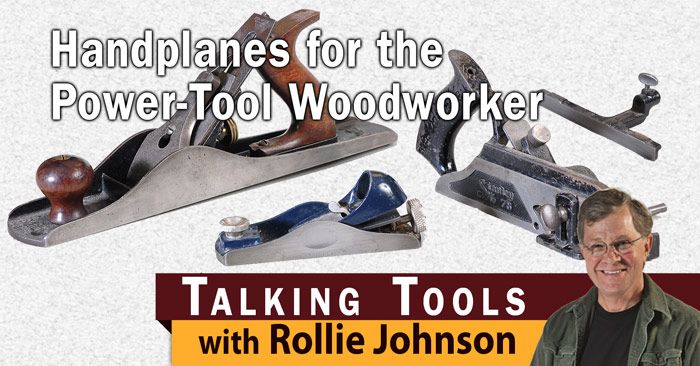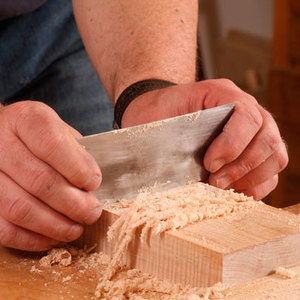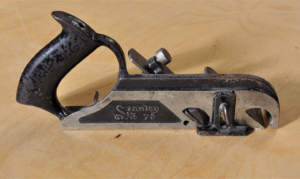Handplanes for the Power-Tool Woodworker
there are a lot of power-tool-centric woodworkers who feel there is no need for handplanes in their shops, it's time to convince the non-believers
I’m on the road with The Woodworking Shows this winter and one of my seminars is entitled “Hand Planes for the Power-Tool Woodworker.” I’ve chosen the topic simply because there are a lot of power-tool-centric woodworkers who feel there is no need for handplanes in their shops. So, of course, I have to try to rectify this misconception and convince the non-believers that handplanes are more than just another reason to spend countless hours cruising eBay.
Before I put the seminar together, I polled quite a few friends and colleagues to get their take on what a basic set of planes should be. The one plane that everybody mentioned was the low-angle, adjustable-throat block plane. I often refer to these little gems as the open-end adjustable wrenches of the handplane family.
The bevel-up, low-angle plane (25° bevel plus 12° bed creates a 37° cutting angle) works incredibly well for trimming end grain, refining edges, and fitting doors and drawers. It can even be an effective smoothing plane on smaller pieces of highly figured wood. The ability to adjust the throat is essential for making fine finish cuts in difficult wood, the same as its larger cousins the bench planes. These planes are readily available on eBay and from antique tool dealers, but watch for cracks on either side of the throat (heel side, typically caused by overtightening the blade cap).
 |
 |
Another plane that was almost universally recommended is the No. 5 jack plane.
Stanley started producing the all-iron Bailey No. 5 sometime around the end of the Civil War and it quickly became a favorite of cabinetmakers and carpenters. It has a sole that is long enough to be a fairly good jointer but still short enough to be a competent smoother. It was considered a “jack of all trades,” which led to the name. I have used my jack plane for flattening one side of stock too wide for my jointer before feeding the board into my planer. I’ve trimmed passage doors, cabinet doors, and used it for a host of other wood-removing shop chores. Because of the high cutting angle (45°), it’s not a champ at trimming end grain like the modern bevel-up jacks, but its general utility makes it a must-have for any shop. Good pre-World War II Stanley Bailey No. 5s are cheap and plentiful, and if they have their original blades they require nothing more than a good sharpening and general tune-up to become a stalwart of the shop.
 The third plane I’d recommend is the Stanley 78, a multi-purpose plane that was originally called a fillister plane. The plane was immensely popular from the late 19th century through WWII as an essential for creating rabbets, cross-ploughing for bridle or lap joints, creating and trimming tenons, and a host of other chores. A rod that threads into the plane body allows the use of a fence for setting the width of a rabbet, and a shoe mounted on the opposite side of the body creates a consistent depth of cut, a perfect combination for creating quick, accurate rabbets.
The third plane I’d recommend is the Stanley 78, a multi-purpose plane that was originally called a fillister plane. The plane was immensely popular from the late 19th century through WWII as an essential for creating rabbets, cross-ploughing for bridle or lap joints, creating and trimming tenons, and a host of other chores. A rod that threads into the plane body allows the use of a fence for setting the width of a rabbet, and a shoe mounted on the opposite side of the body creates a consistent depth of cut, a perfect combination for creating quick, accurate rabbets.
On the side of the plane that holds the depth shoe is a three-lobed device referred to as the nicker. The nicker can be rotated to expose a sharp spur that extends slightly below the sole of the plane and effectively shears the grain of the wood immediately in front of the blade, creating a suitable cross-grain plough plane. The blade and cap can be moved to a forward position, creating an OK bullnose plane. It’s quite a versatile little plane, and because the Stanley 78 was so popular in the day, it’s still plentiful and inexpensive.
That’s my take on a basic set of handplanes. Now let me hear what you’d include in an entry-level handplane set.
Fine Woodworking Recommended Products

Veritas Wheel Marking Gauge

Bahco 6-Inch Card Scraper

Starrett 12-in. combination square



























Comments
I agree that the jack is a very useful plane. I set mine up to take moderate thickness shavings to remove material quickly without tearing up the surface like a scrub plane. But, I would have to insist that the No. 4 be included in my basic set. Setting it up to take fine shavings is best. I think that this combination covers 90% of surface prep needs.
Yes a number 4 smoother should be included. I would recommend the Veritas model or the Lie Nielsen model. Both are pricey but you'll only have to buy them once. I'd also include a number 7 "Minty Sweetheart" jointer.
Since we're talking planes for a converting power tool person, I'd say a router plane would be the one missing most. Realistically a power tool wood worker won't be using these planes to square stock but more likely tune joinery and a router plane is hard to beat in that regard
Although not a plane, it performs like one. A good card scraper is essential for remedying power tool marks and tearout - especially on inconsistent grain.
73
I agree that a #4 Stanley is essential -- mine is a newer Sweetheart that I tuned to take perfect gossamer-thin shavings. Also, once I learned to use it properly -- a spoke shave is indispensable – got both of my vintage Stanley’s for two dollars each at an estate sale – and nothing else really rides the curves and leaves such a lovely, faceted finish. I also keep a small Lie-Nielsen #102 bronze low angel block plane in my apron pocket and I am constantly reaching for it for detailing touchups or beveling delicate edges. At the risk of sounding elitist -- I think too many of we who work in wood have lost the appreciation for the “hand-crafted” part of our craft – constantly seeking the mechanical precision of the routers’ edge and CNC contours and repeatability. Not that I’m opposed to efficiency – especially for those trying to make a living. But why try so hard to make our work look as though it came out of a high-tech factory in Taiwan? I say, strive for perfection, but let “the hand” show in your work.
How about a low angle rabbet block plane. It can trim end grain well, and can service some of the purposes of the Stanley 78. The rabbet block plane has a nicker as well.
The low-angle rabbet block plane is a nice addition but costs more than my three basic planes combined, plus no fence or depth shoe, but a great plane nonetheless. The low angle makes it a great end-grain trimmer.
I'm a big fan of card scrapers but for someone just dipping their toe into the hand work waters it's a bit intimidating. It's a challenge to get a good burr on a card for a beginner.
Smoothers are a great addition, as is a good jointer, but if you only have one bench plane the number 5 is still the ticket.
It's great to get all these responses, thanks. Hand-power is such a freeing concept!
My first plane was a no 7 union joiner great plane for things too wide for my thickness planer next was a 5 1/2 bailey and now 4,3,low angle block plane all great but the best is an old wooden jack plane with an iron that is 1/2 a pound.
bailey
I didn't see anyone mention a shoulder plane. I love mine, and combine a small (1/2") shoulder plane with my little low angle LN plane for tenon sizing. Works pretty well so I call it essential.
You can get a bigger shoulder plane and skip the little low angle plane part, but then I wouldn't have had as many reasons for buying the little plane :) It actually gives me more utility, I think. And I do this as a hobby, not for a living, so speed isn't my main concern (says the guy with all the power tools to go along with all the hand tools).
Log in or create an account to post a comment.
Sign up Log in